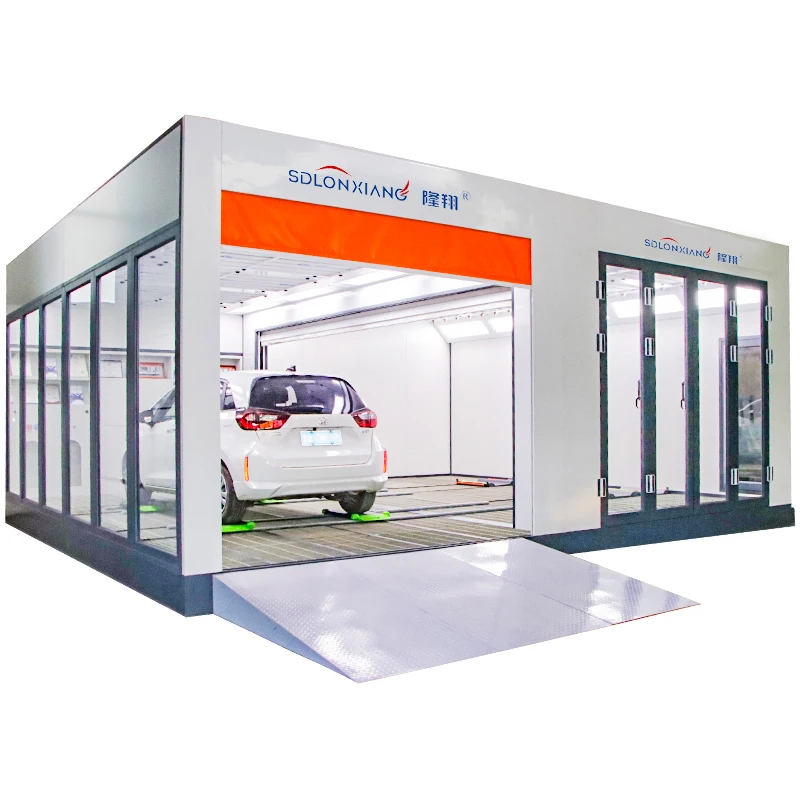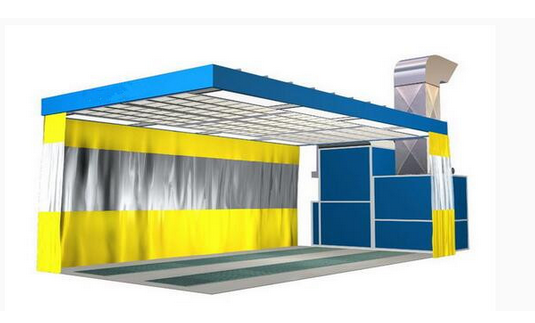Selecting the right spraybooth for your automotive refinishing operation can make the difference between professional-quality results and costly rework. In 2025, the market offers an unprecedented variety of spraybooths designed to meet diverse business needs, from small independent shops to large-scale manufacturing facilities. Understanding the key factors that influence spraybooth performance will help you make an informed investment that enhances productivity, ensures compliance with environmental regulations, and delivers consistent finishing quality. The modern spraybooth industry has evolved significantly, incorporating advanced filtration systems, energy-efficient designs, and smart control technologies that optimize paint application processes while minimizing environmental impact.

Understanding Spraybooth Types and Configurations
Crossdraft Spraybooth Systems
Crossdraft spraybooths represent the most economical entry point for many automotive shops, featuring horizontal airflow patterns that move air from one side of the booth to the other. These systems typically cost less to install and maintain compared to other configurations, making them attractive for budget-conscious operations. The horizontal airflow design effectively captures overspray particles and carries them toward the exhaust system, though paint particles may occasionally contact the vehicle surface during the finishing process.
The simplicity of crossdraft spraybooths translates to lower maintenance requirements and easier troubleshooting procedures. Most technicians can quickly identify and resolve common issues without extensive specialized training. However, the horizontal airflow pattern may result in less uniform paint application compared to downdraft systems, particularly when working on larger vehicles or complex surface geometries.
Downdraft Spraybooth Excellence
Downdraft spraybooths deliver superior finishing quality through vertical airflow patterns that pull contaminated air downward through floor-mounted exhaust systems. This configuration minimizes the risk of paint particles settling on freshly coated surfaces, resulting in smoother finishes with fewer defects. Professional body shops often prefer downdraft systems for high-end refinishing work where finish quality is paramount.
The vertical airflow design requires more complex installation procedures, including excavation for below-ground exhaust plenums or elevated booth structures. Despite higher initial costs, many operators find that improved finish quality and reduced rework justify the additional investment. Modern downdraft spraybooths incorporate sophisticated air distribution systems that ensure uniform airflow across the entire work area.
Key Performance Specifications
Airflow Requirements and Standards
Proper airflow velocity is crucial for effective overspray capture and optimal paint application conditions. Most regulations require minimum airflow rates of 100 feet per minute across the operator's breathing zone, though many modern spraybooths exceed these minimums to provide enhanced safety margins. Higher airflow rates generally improve overspray control but increase energy consumption and operating costs.
Consistent airflow distribution throughout the booth ensures uniform drying conditions and prevents air stagnation that could trap contaminants. Variable frequency drives allow operators to adjust airflow rates based on specific application requirements, optimizing energy usage while maintaining proper ventilation. Regular airflow monitoring and calibration help maintain consistent performance over time.
Filtration System Efficiency
Advanced filtration technology plays a critical role in maintaining clean air environments and protecting downstream equipment from paint buildup. Primary filters capture larger particles and overspray, while secondary filtration systems remove finer contaminants that could affect finish quality. High-efficiency particulate air filters provide the ultimate level of contamination control for demanding applications.
Filter replacement schedules directly impact operational costs and system performance. Operators must balance filtration efficiency with filter life to optimize total cost of ownership. Pressure differential monitoring systems alert operators when filters require replacement, preventing system performance degradation and maintaining consistent air quality standards.
Size and Space Considerations
Vehicle Accommodation Requirements
Spraybooth dimensions must accommodate the largest vehicles routinely serviced while providing adequate working space around all surfaces. Standard passenger car booths typically measure 14 feet wide by 24 feet long, though commercial vehicle operations may require significantly larger dimensions. Height considerations include spray gun reach, lighting installation, and adequate clearance for vehicle entry and exit.
Future business expansion plans should influence sizing decisions, as retrofitting or relocating spraybooths involves substantial costs. Many operators choose slightly oversized booths to accommodate occasional larger vehicles or multiple smaller units simultaneously. Modular booth designs offer flexibility for future expansion without complete system replacement.
Facility Integration Challenges
Existing building structures often constrain spraybooth installation options, requiring careful planning to optimize placement and utility connections. Adequate clearances around the booth ensure proper maintenance access and emergency egress. HVAC integration with existing facility systems requires coordination to prevent interference with booth performance.
Structural modifications may be necessary to support booth weight and withstand operational loads. Professional structural analysis ensures safe installation and compliance with building codes. Utility requirements include electrical power, compressed air, and ventilation connections that must be properly sized and located for optimal performance.
Energy Efficiency and Operating Costs
Heating System Technologies
Modern spraybooth heating systems offer various fuel options and efficiency levels that significantly impact long-term operating costs. Natural gas systems typically provide the lowest operating costs in most regions, while electric heating offers precise temperature control and simplified installation. Heat recovery systems capture waste heat from exhaust air to preheat incoming fresh air, reducing overall energy consumption.
Variable temperature controls allow operators to optimize curing conditions for different coating systems while minimizing energy waste. Programmable temperature profiles automatically adjust heating cycles based on specific job requirements. Insulation quality directly affects heating efficiency and should be evaluated as part of the total system performance.
Operational Cost Management
Comprehensive cost analysis includes initial purchase price, installation expenses, ongoing maintenance requirements, and energy consumption over the expected system lifespan. Higher-efficiency systems often justify premium pricing through reduced operating costs and improved productivity. Regular maintenance scheduling prevents costly repairs and maintains optimal system performance.
Energy monitoring systems provide real-time feedback on system performance and identify opportunities for efficiency improvements. Operator training programs ensure proper system utilization and maintenance procedures. Total cost of ownership calculations should include all direct and indirect costs associated with spraybooth operation.
Compliance and Safety Standards
Environmental Regulations
Volatile organic compound emission limits continue to tighten, requiring spraybooth systems that effectively capture and control paint vapors. Local air quality management districts may impose additional restrictions beyond federal standards. Proper documentation and reporting procedures ensure ongoing compliance with environmental regulations.
Advanced emission control systems, including thermal oxidizers and carbon adsorption units, may be required in certain jurisdictions. These systems add complexity and cost but enable operation in areas with strict environmental controls. Regular emissions testing and monitoring verify continued compliance and system effectiveness.
Fire Safety Requirements
Fire suppression systems must be specifically designed for paint spray environments, with appropriate detection and suppression agents. Explosion-proof electrical components prevent ignition sources in hazardous atmospheres. Proper grounding and bonding procedures eliminate static electricity buildup that could cause fires or explosions.
Emergency shutdown systems provide rapid response to dangerous conditions, automatically stopping all booth operations and activating safety protocols. Regular fire safety inspections and maintenance ensure reliable protection. Staff training on emergency procedures and equipment operation is essential for maintaining safe working conditions.
Installation and Maintenance Considerations
Professional Installation Requirements
Qualified installation teams ensure proper assembly, testing, and commissioning of spraybooth systems according to manufacturer specifications and local codes. Experienced installers understand the critical importance of proper sealing, alignment, and calibration for optimal performance. Professional installation typically includes warranty coverage and ongoing support services.
Site preparation requirements may include concrete work, utility installations, and structural modifications that add time and cost to the project. Coordinating multiple trades and obtaining necessary permits requires experienced project management. Proper planning prevents delays and ensures smooth installation processes.
Preventive Maintenance Programs
Regular maintenance schedules extend equipment life and maintain optimal performance throughout the system's operational life. Filter replacement, motor lubrication, and control system calibration should follow manufacturer recommendations. Detailed maintenance records help identify trends and predict component replacement needs.
Trained maintenance personnel can perform routine tasks, while complex repairs may require factory-certified technicians. Spare parts inventory management ensures minimal downtime during maintenance periods. Scheduled maintenance during off-peak periods minimizes disruption to production schedules.
FAQ
What size spraybooth do I need for my shop
Spraybooth size depends on the largest vehicles you regularly service plus adequate working space around all surfaces. Standard passenger car booths measure approximately 14 by 24 feet, while truck and commercial vehicle operations require larger dimensions. Consider future expansion plans and occasional oversized jobs when selecting booth dimensions. Professional assessment of your specific needs ensures optimal sizing decisions.
How much does a quality spraybooth cost
Spraybooth pricing varies significantly based on size, configuration, and features, typically ranging from $15,000 for basic systems to over $100,000 for advanced installations. Installation costs, site preparation, and utility connections add substantial additional expenses. Consider total cost of ownership including energy consumption, maintenance, and productivity improvements when evaluating options. Financing programs may be available to spread costs over time.
What maintenance is required for spraybooths
Regular maintenance includes filter replacement, motor lubrication, control calibration, and thorough cleaning of all surfaces. Filter replacement frequency depends on usage levels and paint types, typically ranging from weekly to monthly intervals. Annual professional inspections identify potential issues before they cause costly breakdowns. Maintaining detailed service records helps optimize maintenance schedules and warranty coverage.
Do I need special permits for spraybooth installation
Most jurisdictions require building permits for spraybooth installation, along with environmental permits for air emissions and waste disposal. Fire department approvals may be necessary for fire suppression systems and hazardous material storage. Local air quality management districts often have specific requirements for volatile organic compound emissions. Professional guidance helps navigate the permitting process and ensure full compliance.

